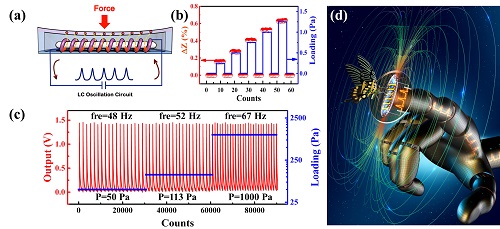A research team led by Prof. Li Runwei at the Ningbo Institute of Materials Technology and Engineering (NIMTE), Chinese Academy of Sciences, has developed a flexible tactile sensor that could be used in the electronic skin and is able to detect subtle changes such as moving ants, in cooperation with the National Institute for Materials Science in Japan.
The electronic skin is a tactile system for the handicapped to restore their tactile sensation. Different from the human skin, most of electronic skins can only convert external stimuli into analog signals instead of physiological responses, which are transferred to the brain via the nervous system. To address this problem, Prof. Li Runwei, Assoc. Prof. Liu Yiwei and PhD candidate Wu Yuanzhao designed an LC circuit (as shown in Fig. 1a), whose frequency changes with the variation of inductance brought by external stress / strain. The researchers are confident that the circuit could be applicable to electronic skins once it is optimized in according with the range of physiological signals in the human body.
Besides, they also designed an air gap structure (as shown in Fig. 1a) using amorphous wires as its magnetic core. With this design, they developed a digital flexible tactile sensor with a sensitivity of 4.4 kPa-1 and a detection limit of 10 μN (equivalent to 0.3 Pa, as shown in Fig. 1b). By adjusting its modulus and structure, the sensor could have a wider detection range. In other words, it could detect both subtle and strenuous events such as moving ants and lifting heavy weights.
With such high sensitivity and superb bionic features, the researchers believe that the tactile sensor has a potential to renovate the situation of the physically challenged via giving them an artificial “tactile organ”.
This work was published in Science Robotics (Sci. Robot. 2018, 3, eaat0429, http://robotics.sciencemag.org/content/3/22/eaat0429.full), and it was supported by various projects and programs including the National Science Fund for Distinguished Young Scholars of China (No. 51525103), China International Cooperation Project (No. 2016YFE0126700), National Natural Foundation of China (Nos. 61704177, 11474295 and 61774161) and Ningbo Science and Technology Innovation Team Program (No. 2015B11001).

Fig.1 (a) Schematic illustration of the operating mechanism of the device;
(b) Response of the sensor to a pressure of 0.3 Pa;
(c) The digital-frequency response of the device changed with applied pressure;
(d) Schematic diagram of the sensor.
Related article:
Please refer to https://techxplore.com/news/2018-09-e-skin-ants.html
(Courtesy of Li Runwei, Liu Yiwei and Wu Yuanzhao)

